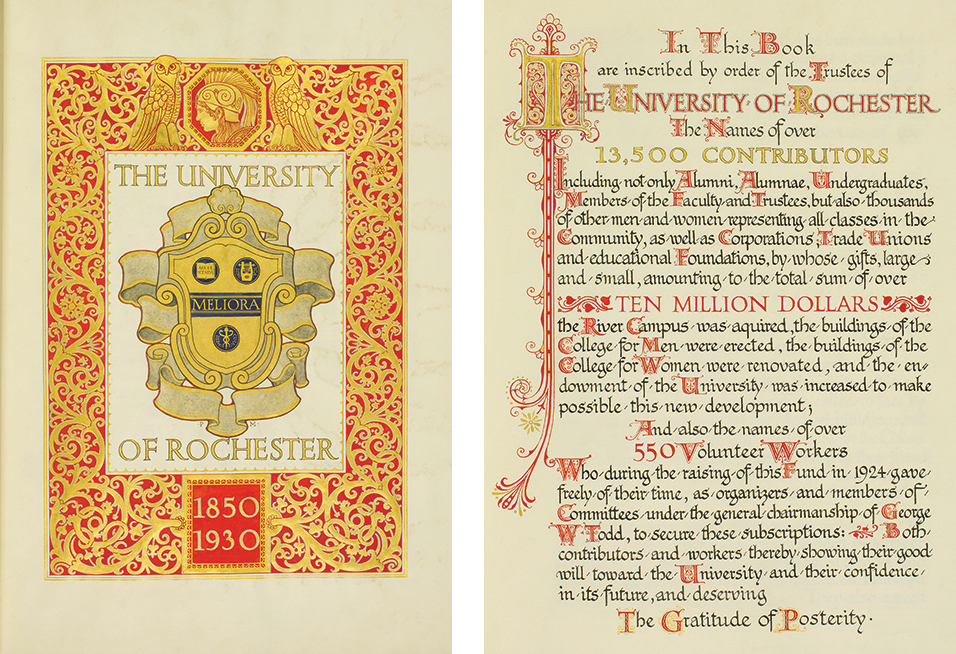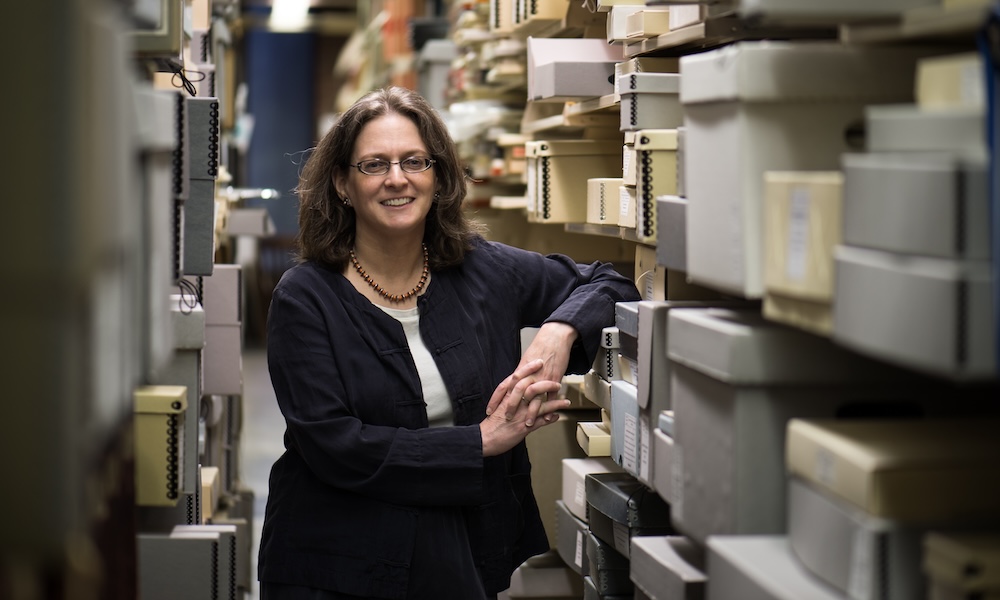A question for Melissa Mead, the John M. and Barbara Keil University Archivist and Rochester Collections Librarian.
Need history?
Do you have a question about University history? Email it to rochrev@rochester.edu. Please put “Ask the Archivist” in the subject line.
As an anthropology student, I have been making efforts to avoid becoming a “fish trying to describe water” by regularly questioning my routine environment. One day my friend Michael and I decided to stop and intentionally read the inscriptions on the doors of the Rush Rhees Library—beautiful features often taken for granted.
This led us to read the engravings on the walls of the lobby, informing onlookers about the development of the River Campus. A particular line stood out to us: “The names of all the givers and solicitors have been inscribed in a book which will be permanently preserved in this library.”
Our question to you is: does this mystical book actually exist? What is its significance, and how might a mere book reflect the grandeur of the campus’s constructional philosophy and donations?
—Joshua Jung ’26 and Michael Ding ’26
Your question could not be more timely, as we approach the centennial of the November 1924 Greater University Campaign that funded the construction of the River Campus. With the goal of raising “ten million in ten days,” the effort had contributions from schoolchildren and principals, office workers and executives—and just a few philanthropists—at giving levels from pennies to millions.
How do you say “thank you” for a brand-new campus? President Rush Rhees had heard of the “books of remembrance” that recorded the names of British soldiers killed in the first World War. He wanted something equally distinctive for the University’s donors, along with the library inscription you discovered.
But while the Greater University Campaign lasted 10 days and the campus construction required three years, 13 years would pass before the book was completed. If its existence had not literally been carved in stone, it might have been forgotten.
Initially, the volume was to be ready in time for the campus opening on October 10, 1930. Just one week before, a letter from University Treasurer Raymond Thompson to University Librarian Donald Gilchrist contains the admonition, “Dr. Rhees wants this book exhibited in the Library at the time of the Dedication Exercises. . . . We must, of course, comply with [his] request without fail.”

But they did fail. A printed book might have been finished in time but would have lacked the desired splendor. Instead, the project was entrusted to Philipp Merz. The designer of the University seal and mace, Merz worked for architects McKim, Mead, and White on the Eastman Theatre and then was hired by Gordon and Kaelber for the River Campus.
In December 1931, Merz consulted Gilchrist about the book. Gilchrist suggested a visit to collector George A. Plimpton, who would “undoubtedly be delighted to permit you to examine the greatest collection of calligraphy, which he happens to own.”
The job was monumental: The 228-page book includes the names of 13,711 donors and the 738 men and women who participated in the fundraising. It is possible that Merz grew bored with repetitive parts of the task, because despite Thompson’s numerous letters, by 1938 only about 68 pages had been received. By June 1941, something had to be done, especially after librarian John R. Russell reported an encounter much like your own: “Another visitor has just asked to see [the book], after reading the carved statement in the foyer.”
With no word from Merz, the University found an accomplished calligrapher closer to home. Ruth E. Gutfrucht, soon to begin a long and illustrious career on the faculty of RIT, worked quickly but still required a year.
By July 1943, the completed book, bound in dark blue leather, was on display at last. It does match the campus’s grandeur and the contributors’ generosity, blending expert calligraphy, sparkling gold leaf, and crisp handmade paper, and featuring the familiar design elements that Merz created for the Eastman School and River Campus and that we are so fortunate to enjoy in our “routine environment.”
Learn more and view some pages of the Greater University Fund book.
This installment of “Ask the Archivist” appears in the summer 2024 issue of Rochester Review, the magazine of the University of Rochester.




